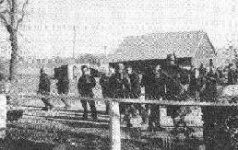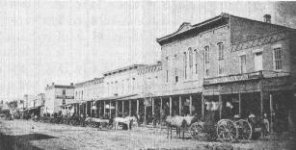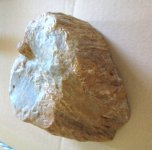Gypsy Heart
Gold Member
Looks like a great place to hunt.....Polo is located in Ogle County, in the state of Illinois, in the USA. This booming metropolis has about 2600 people, a grocery store, a handful of bars and not a single stoplight.
The exact location of Polo is 41.985 north latitude, 89.578 west longitude
Before 1857, a well was dug in the center of the Mason and Franklin Sts. crossing. This was called "The Town Pump." The well was equipped with a pump and a watering trough for horses. Later, a bandstand was built over the well. In 1890 or '91, Mason St., two blocks of Franklin St. and several of Division St. were paved with stone. Some thought the bandstand an eye-sore and should be removed. One night, Col. Morton D. Swift and a group of men sawed off the posts supporting the bandstand. Years later the Polo Band played its concerts from a platform set on a hay rack at the same location where once was a bandstand. An old windmill, round stone tower, about 36 feet in diameter and 50 feet high stood where the stand-pipe is today. It was not a success. Seldom was there wind enough to run it. Andrew Hitt bought it in 1866 and used the stone to build the store building where Muench's Shoe Store is in 1975.
Bicentennial History of Ogle County. Ogle County Board, 1976.
For two years (1943-1944), Polo was thrust the limelight because during those World War II years, hemp. (marijuana) was raised in the area, and a mill for preparing the hemp into rope or cordage was built.
With the fall of the Philippines and Java to Japan, the major supply of harder fibers was cut off. So in 1942 the United States government decided it would be necessary to produce large quantities of hemp fiber in this country to meet the armed forces' demands for rope, binder twine, and other types of cordage.
By January 6, 1944, four thousand five-hundred and fifty-two truck loads of hemp had been hauled to the mill. At the peak of the milling, 144 workers processed the hemp into line fiber. By February, 151 tons of fiber were recovered and the fiber was shipped to the East coast. Fifteen spinning mills received the fiber.
The Tri-County Press, of Polo, reported that on March 16 the Polo mill processed more tonnage than any other mill in the United States for the 1943 season. The Polo plant received hemp from 365 farmers whose total crop from 1,825 acres was 10,635 tons of hemp straw. Hemp brought an average of $93.19 per acre to farmers on the Polo area.
The early settlers in Buffalo Grove took a strong anti-slavery position. From 1842 until 1860, Buffalo Grove and Polo were stations on, and actively connected with, the Illinois branch of the "Great Underground Railroad," extending from all parts of the slave states to the Canadian frontier. Abolitionists traveled in the night concealing their passengers in the bottoms of their wagons, under straw or buffalo robes. They received their passengers from Sugar Grove in Lee County and delivered them to Byron to a minister. By 1856-57 they ran their trains in the daylight, the threat of discovery was so small. The man responsible for the participation of area people in the underground railroad was Judge Bogue of Buffalo Grove.
Voice of the Prairie: A Brief History of Polo, Illinois. Polo IL, 1957.
The exact location of Polo is 41.985 north latitude, 89.578 west longitude
Before 1857, a well was dug in the center of the Mason and Franklin Sts. crossing. This was called "The Town Pump." The well was equipped with a pump and a watering trough for horses. Later, a bandstand was built over the well. In 1890 or '91, Mason St., two blocks of Franklin St. and several of Division St. were paved with stone. Some thought the bandstand an eye-sore and should be removed. One night, Col. Morton D. Swift and a group of men sawed off the posts supporting the bandstand. Years later the Polo Band played its concerts from a platform set on a hay rack at the same location where once was a bandstand. An old windmill, round stone tower, about 36 feet in diameter and 50 feet high stood where the stand-pipe is today. It was not a success. Seldom was there wind enough to run it. Andrew Hitt bought it in 1866 and used the stone to build the store building where Muench's Shoe Store is in 1975.
Bicentennial History of Ogle County. Ogle County Board, 1976.
For two years (1943-1944), Polo was thrust the limelight because during those World War II years, hemp. (marijuana) was raised in the area, and a mill for preparing the hemp into rope or cordage was built.
With the fall of the Philippines and Java to Japan, the major supply of harder fibers was cut off. So in 1942 the United States government decided it would be necessary to produce large quantities of hemp fiber in this country to meet the armed forces' demands for rope, binder twine, and other types of cordage.
By January 6, 1944, four thousand five-hundred and fifty-two truck loads of hemp had been hauled to the mill. At the peak of the milling, 144 workers processed the hemp into line fiber. By February, 151 tons of fiber were recovered and the fiber was shipped to the East coast. Fifteen spinning mills received the fiber.
The Tri-County Press, of Polo, reported that on March 16 the Polo mill processed more tonnage than any other mill in the United States for the 1943 season. The Polo plant received hemp from 365 farmers whose total crop from 1,825 acres was 10,635 tons of hemp straw. Hemp brought an average of $93.19 per acre to farmers on the Polo area.
The early settlers in Buffalo Grove took a strong anti-slavery position. From 1842 until 1860, Buffalo Grove and Polo were stations on, and actively connected with, the Illinois branch of the "Great Underground Railroad," extending from all parts of the slave states to the Canadian frontier. Abolitionists traveled in the night concealing their passengers in the bottoms of their wagons, under straw or buffalo robes. They received their passengers from Sugar Grove in Lee County and delivered them to Byron to a minister. By 1856-57 they ran their trains in the daylight, the threat of discovery was so small. The man responsible for the participation of area people in the underground railroad was Judge Bogue of Buffalo Grove.
Voice of the Prairie: A Brief History of Polo, Illinois. Polo IL, 1957.







